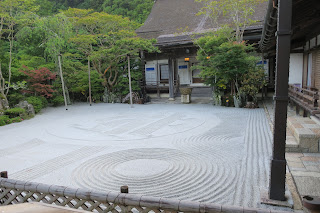Rengejo-in temple is located in the northwestern part of Isshin-in Valley.
The present-day main hall (hondo), kitchen (kuri), and main gate
(sanmon) were reconstructed in 1860 with the support of the Sanada
clan. Having survived a major fire in 1888, the temple retains the prestige of
an Edo Period feudal lord’s temple.
Rengejo-in features accommodation with a garden and free WiFi throughout the
property as well as free private parking for guests who drive. This 4-star
ryokan offers luggage storage space. Guests can enjoy garden views. At the
ryokan the rooms include air conditioning and a safety deposit box. An Asian
breakfast is available each morning.
|
Main gate.
The Main gate (sanmon) welcoming visitors is adorned with large
paper lanterns raised on poles and bearing the Sanada family crest (the
Rokumonsen) and a tablet attesting to the gate’s reconstruction in 1860
with the support of the Sanada clan.
|
|
Dry garden (left) and entrance door (center).
|
|
Dry garden (Karesansui).
The temple’s front garden is made in the karesansui style that
was established in the late Kamakura Period (14th century). Also called
“dry gardens” or “rock gardens,” karesansui gardens use stones,
sand, plants, and trees to represent ponds and flowing rivers,
expressing the Buddhist view of the world, the universe, and the state
of enlightenment.
-
The pattern drawn in the sand shows the Sanskrit character
hrih. The hrih depicted in the sand pattern represents a
lotus (renge in Japanese) flower with Amida Nyorai seated in
zen meditation on it.
-
When one enters the temple grounds, it points straight to the temple’s
principal image of Amida Nyorai, the hidden Buddha enshrined in the
main hall, like a spiritual line connecting the prayerful visitors to
Amida Nyorai.
|
|
Shoes are left at the entrance.
Inside, you can only walk with the slippers that are provided at the
entrance.
|
|
Buddhist altar (Butsudan).
A Buddhist altar (Butsudan), sometimes spelled Butudan, is a shrine
commonly found in temples and homes in Japanese Buddhist cultures.
-
A Buddhist altar (Butsudan) is either a defined, often ornate platform
or simply a wooden cabinet sometimes crafted with doors that enclose
and protect a religious icon (Gohonzon), typically a statue or
painting of a Buddha or Bodhisattva, or a calligraphic mandala scroll.
-
The butsudan's primary use is for paying respects to the Buddha, as
well as to family members who have died.
-
See more at
Butsudan - Wikipedia.
|
|
Meal room.
A framed calligraphy piece reading “Sanadabo” hangs in the reception
room.
-
It was presented to the temple in 1942 by the then-head of the Sanada
family and is proof of the enduring relationship between Rengejo-in
and the Sanada family from the Warring States Period to the present.
-
This work of calligraphy is considered another one of the temple’s
precious treasures to be handed down to future generations.
|
|
Courtyard.
The courtyard is home to a pine tree that is over 500 years old and a
maple tree that escaped the flames of the fire that broke out during the
Tempo Period and continues to live today.
-
When you reflect on the fact that Lord Sanada Masayuki and his son
Nobushige would have viewed this very garden, you can feel the passage
of time from the Warring States Period (1467-1615) and the transitions
of nature that are a unique feature of mountain temples.
|
See also
Source
Location






























